#prehistory of gender roles
Text
In a further blow to the Gimbutas hypothesis, the first archaeological traces of gender roles begins in the Neolithic:
It should be worth restating that humanity has been on Earth physically for at least 300,000 years. And that as the net is cast ever further it appears that with the appearance of our species in flesh so went changes in behavior, that there never was some sort of a 'sapience revolution' or the perennial efforts to recreate 'and God made mankind in his image, and gave to him the breath of life to make him unique among the beasts and with dominion over them' in a scientific guise. When gender roles began to appear starting in the last 7,000 years this is a tiny, tiny portion of the ultimate span of human existence, as is the history of civilization itself.
This should be put into context, and serve as context, for both the degree to which archaeology attests to the reality of violence and the beginning of the symbolic depictions of ideal worlds that differ from the reality. This is, and has always been, a reality of gender roles as they evolved and their expectations, with the ideologies of what was expected for women always being defined as inferior to what was expected of men. Equally the societies of the Neolithic were crude compared to later eras that had greater wealth to pour into ideological indoctrination and greater power to make it stick
#lightdancer comments on prehistory#women's history month#neolithic#prehistoric women#prehistory of gender roles
4 notes
·
View notes
Text
Ramsl, P. C. (2020) Diversity of male identities in early and middle La Tène period cemeteries in Central Europe. Nitra: Archeologický ústav SAV
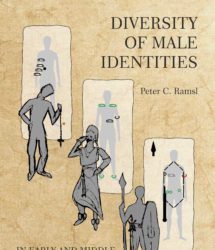
166.p.
"As written in the chapter by J. Gretzinger and St. Schiffels in this book, it is clear by analyzing the DNA that this is a biological man. As mentioned above, it is a special case, proved by two methods. Therefore, it is up to archaeology to provide an interpretation. According to my best knowledge, it is the first proven case of a male person in the early Iron Age who is wearing part of a ‘typical female costume’ – so not only some female marker, but an extraordinary one."
3 notes
·
View notes
Text
Analysis of data from dozens of foraging societies around the world shows that women hunt in at least 79% of these societies, opposing the widespread belief that men exclusively hunt and women exclusively gather. Abigail Anderson of Seattle Pacific University, US, and colleagues presented these findings in the open-access journal PLOS ONE on June 28, 2023.
A common belief holds that, among foraging populations, men have typically hunted animals while women gathered plant products for food. However, mounting archaeological evidence from across human history and prehistory is challenging this paradigm; for instance, women in many societies have been found buried alongside big-game hunting tools.
Some researchers have suggested that women's role as hunters was confined to the past, with more recent foraging societies following the paradigm of men as hunters and women as gatherers. To investigate that possibility, Anderson and colleagues analyzed data from the past 100 years on 63 foraging societies around the world, including societies in North and South America, Africa, Australia, Asia, and the Oceanic region.
They found that women hunt in 79% of the analyzed societies, regardless of their status as mothers. More than 70% of female hunting appears to be intentional—as opposed to opportunistic killing of animals encountered while performing other activities, and intentional hunting by women appears to target game of all sizes, most often large game.
The analysis also revealed that women are actively involved in teaching hunting practices and that they often employ a greater variety of weapon choice and hunting strategies than men.
These findings suggest that, in many foraging societies, women are skilled hunters and play an instrumental role in the practice, adding to the evidence opposing long-held perceptions about gender roles in foraging societies. The authors note that these stereotypes have influenced previous archaeological studies, with, for instance, some researchers reluctant to interpret objects buried with women as hunting tools. They call for reevaluation of such evidence and caution against misapplying the idea of men as hunters and women as gatherers in future research.
The authors add, "Evidence from around the world shows that women participate in subsistence hunting in the majority of cultures."
22K notes
·
View notes
Text

(...) proponents of the Man the Hunter theory assumed evolution was acting primarily on men, and women were merely passive beneficiaries of both the meat supply and evolutionary progress.
(...) The modern physiological evidence, along with historical examples, exposes deep flaws in the idea that physical inferiority prevented females from partaking in hunting during our evolutionary past. The evidence from prehistory further undermines this notion.
(...) For those practicing a foraging subsistence strategy in small family groups, flexibility and adaptability are much more important than rigid roles, gendered or otherwise. Individuals get injured or die, and the availability of animal and plant foods changes with the seasons. All group members need to be able to step into any role depending on the situation, whether that role is hunter or breeding partner.
more discussion of the specific evidence in the article -- please give it a read! full text under readmore if you cant get the link to work
The Theory That Men Evolved to Hunt and Women Evolved to Gather Is Wrong
Cara Ocobock, Sarah Lacy
18 - 23 minutes
Even if you're not an anthropologist, you've probably encountered one of this field's most influential notions, known as Man the Hunter. The theory proposes that hunting was a major driver of human evolution and that men carried this activity out to the exclusion of women. It holds that human ancestors had a division of labor, rooted in biological differences between males and females, in which males evolved to hunt and provide and females tended to children and domestic duties. It assumes that males are physically superior to females and that pregnancy and child-rearing reduce or eliminate a female's ability to hunt.
Man the Hunter has dominated the study of human evolution for nearly half a century and pervaded popular culture. It is represented in museum dioramas and textbook figures, Saturday morning cartoons and feature films. The thing is, it's wrong.
Mounting evidence from exercise science indicates that women are physiologically better suited than men to endurance efforts such as running marathons. This advantage bears on questions about hunting because a prominent hypothesis contends that early humans are thought to have pursued prey on foot over long distances until the animals were exhausted. Furthermore, the fossil and archaeological records, as well as ethnographic studies of modern-day hunter-gatherers, indicate that women have a long history of hunting game. We still have much to learn about female athletic performance and the lives of prehistoric women. Nevertheless, the data we do have signal that it is time to bury Man the Hunter for good.
youtube
The theory rose to prominence in 1968, when anthropologists Richard B. Lee and Irven DeVore published Man the Hunter, an edited collection of scholarly papers presented at a 1966 symposium on contemporary hunter-gatherer societies. The volume drew on ethnographic, archaeological and paleoanthropological evidence to argue that hunting is what drove human evolution and resulted in our suite of unique features. "Man's life as a hunter supplied all the other ingredients for achieving civilization: the genetic variability, the inventiveness, the systems of vocal communication, the coordination of social life," anthropologist William S. Laughlin writes in chapter 33 of the book. Because men were supposedly the ones hunting, proponents of the Man the Hunter theory assumed evolution was acting primarily on men, and women were merely passive beneficiaries of both the meat supply and evolutionary progress.
But Man the Hunter's contributors often ignored evidence, sometimes in their own data, that countered their suppositions. For example, Hitoshi Watanabe focused on ethnographic data about the Ainu, an Indigenous population in northern Japan and its surrounding areas. Although Watanabe documented Ainu women hunting, often with the aid of dogs, he dismissed this finding in his interpretations and placed the focus squarely on men as the primary meat winners. He was superimposing the idea of male superiority through hunting onto the Ainu and into the past.
This fixation on male superiority was a sign of the times not just in academia but in society at large. In 1967, the year between the Man the Hunter conference and the publication of the edited volume, 20-year-old Kathrine Switzer entered the Boston Marathon under the name "K. V. Switzer," which obscured her gender. There were no official rules against women entering the race; it just was not done. When officials discovered that Switzer was a woman, race manager Jock Semple attempted to push her physically off the course.
At that time, the conventional wisdom was that women were incapable of completing such a physically demanding task and that attempting to do so could harm their precious reproductive capacities. Scholars following Man the Hunter dogma relied on this belief in women's limited physical capacities and the assumed burden of pregnancy and lactation to argue that only men hunted. Women had children to rear instead.
Today these biased assumptions persist in both the scientific literature and the public consciousness. Granted, women have recently been shown hunting in movies such as Prey, the newest installment of the popular Predator franchise, and on cable programs such as Naked and Afraid and Women Who Hunt. But social media trolls have viciously critiqued and labeled these depictions as part of a politically correct feminist agenda. They insist the creators of such works are trying to rewrite gender roles and evolutionary history in an attempt to co-opt "traditionally masculine" social spheres. Bystanders might be left wondering whether portrayals of women hunters are trying to make the past more inclusive than it really was—or whether Man the Hunter-style assumptions about the past are attempts to project sexism backward in time. Our recent surveys of the physiological and archaeological evidence for hunting capability and sexual division of labor in human evolution answer this question.

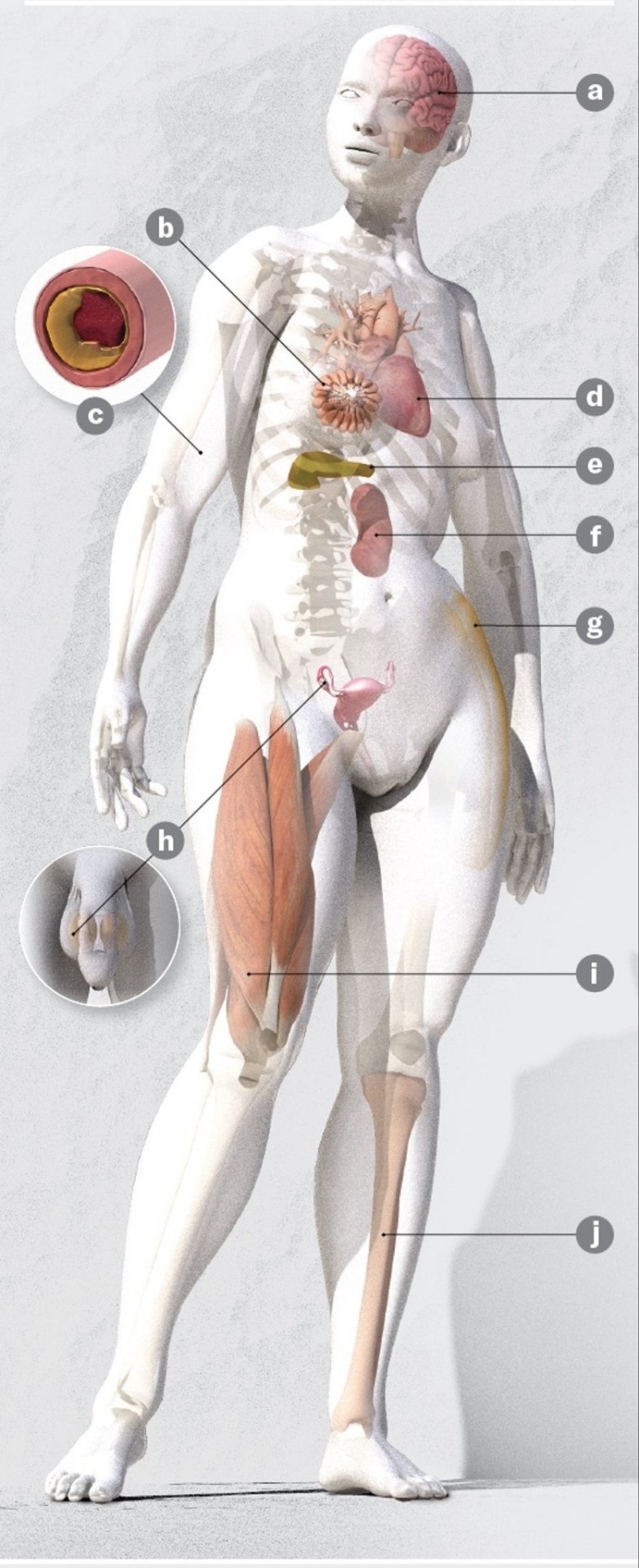
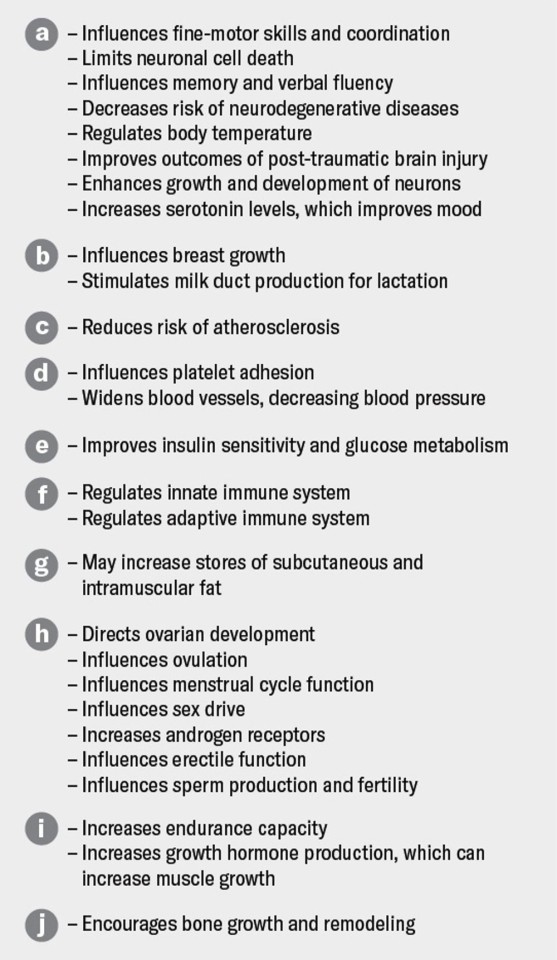
Credit: Violet Isabelle Frances for Bryan Christie Design
Before getting into the evidence, we need to first talk about sex and gender. "Sex" typically refers to biological sex, which can be defined by myriad characteristics such as chromosomes, hormone levels, gonads, external genitalia and secondary sex characteristics. The terms "female" and "male" are often used in relation to biological sex. "Gender" refers to how an individual identifies—woman, man, nonbinary, and so forth. Much of the scientific literature confuses and conflates female/male and woman/man terminology without providing definitions to clarify what it is referring to and why those terms were chosen. For the purpose of describing anatomical and physiological evidence, most of the literature uses "female" and "male," so we use those words here when discussing the results of such studies. For ethnographic and archaeological evidence, we are attempting to reconstruct social roles, for which the terms "woman" and "man" are usually used. Unfortunately, both these word sets assume a binary, which does not exist biologically, psychologically or socially. Sex and gender both exist as a spectrum, but it is difficult to add that nuance when citing the work of others.
It also bears mentioning that much of the research into exercise physiology, paleoanthropology, archaeology and ethnography has historically been conducted by men and focused on males. For example, Ella Smith of the Australian Catholic University and her colleagues found that in studies of nutrition and supplements, only 23 percent of participants were female. Emma Cowley, then at the University of North Carolina at Chapel Hill, and her colleagues found that among published studies focusing on athletic performance, only 6 percent had female-only participants; 31 percent looked exclusively at males. This massive disparity means we still know very little about female athletic performance, training and nutrition, leaving athletic trainers and coaches to treat females mostly as small males. It also means that much of the work we have to rely on to make our physiological arguments about female hunters in prehistory is based on research with small human sample sizes or rodent studies. We hope this state of affairs will inspire the next generation of scientists to ensure that females are represented in such studies. But even with the limited data available to us, we can show that Man the Hunter is a flawed theory and make the case that females in early human communities hunted, too.
From a biological standpoint, there are undeniable differences between females and males. When we discuss these differences, we are typically referring to means, averages of one group compared with another. Means obscure the vast range of variation in humans. For instance, although males tend to be larger and to have bigger hearts and lungs and more muscle mass, there are plenty of females who fall within the typical male range; the inverse is also true.
Overall, females are metabolically better suited for endurance activities, whereas males excel at short, powerful burst-type activities. You can think of it as marathoners (females) versus powerlifters (males). Much of this difference seems to be driven by the powers of the hormone estrogen.
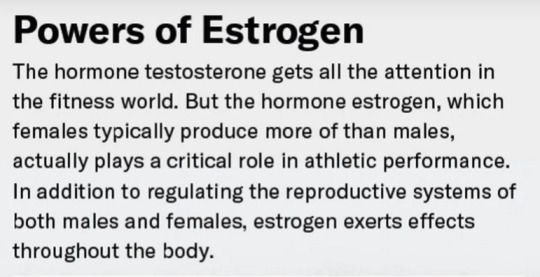
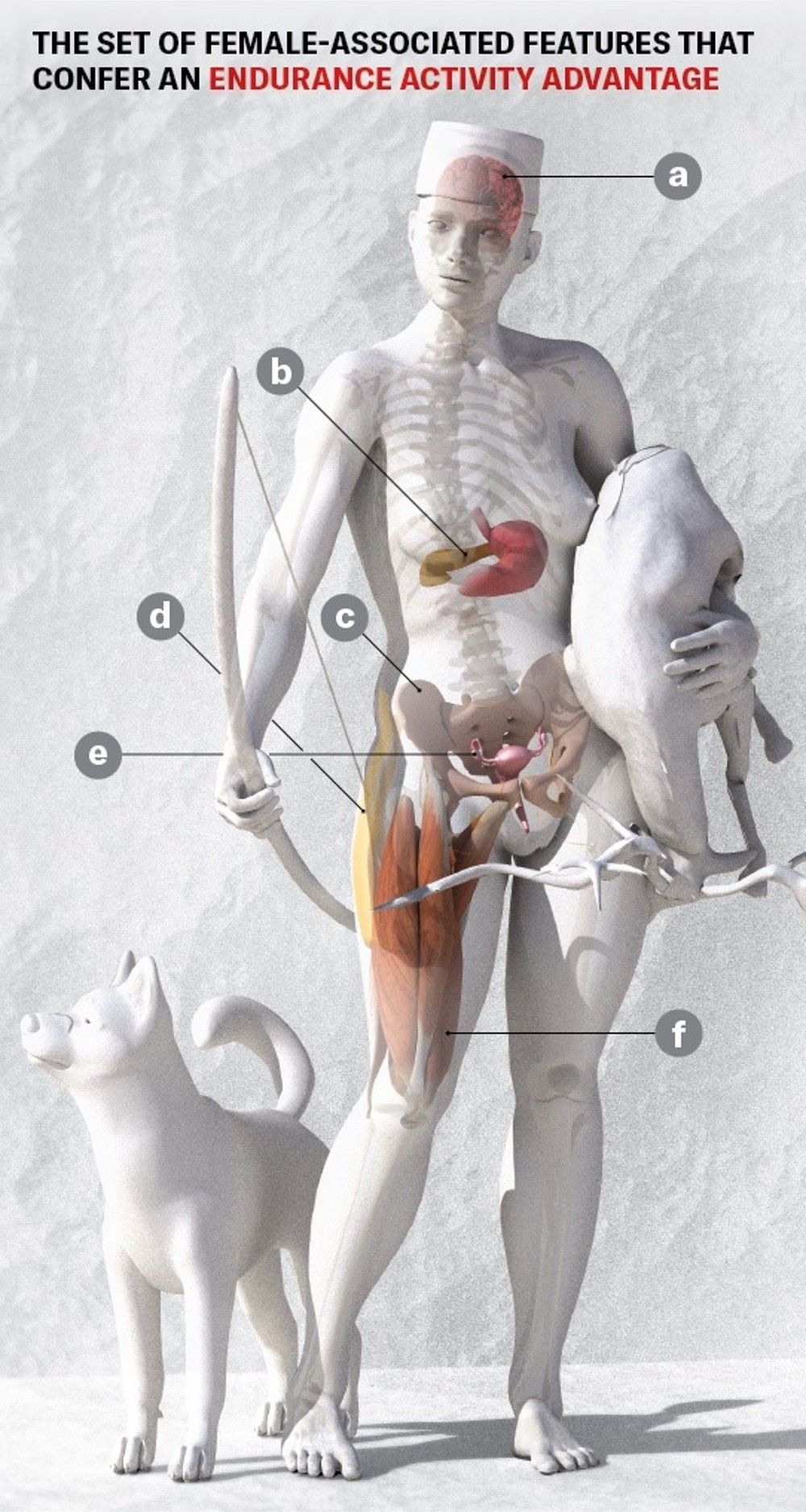
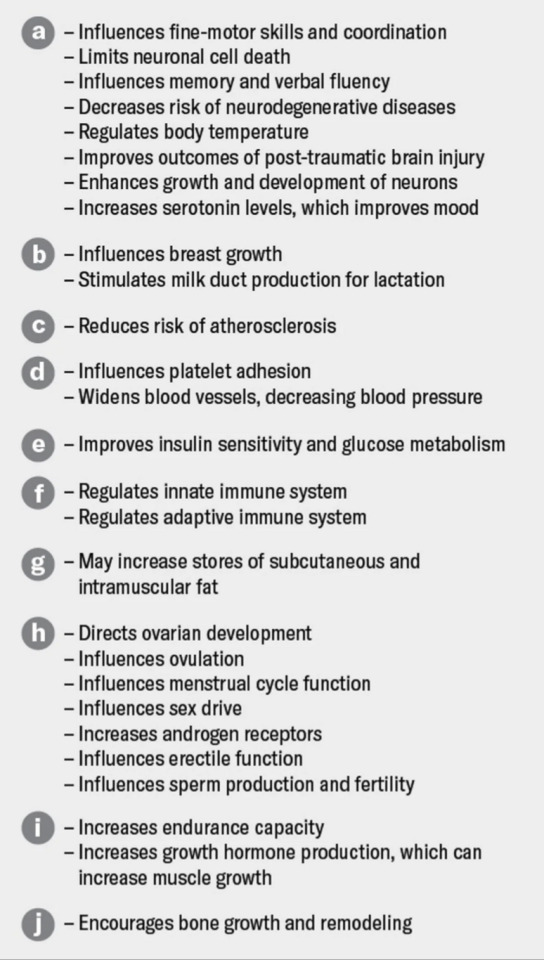
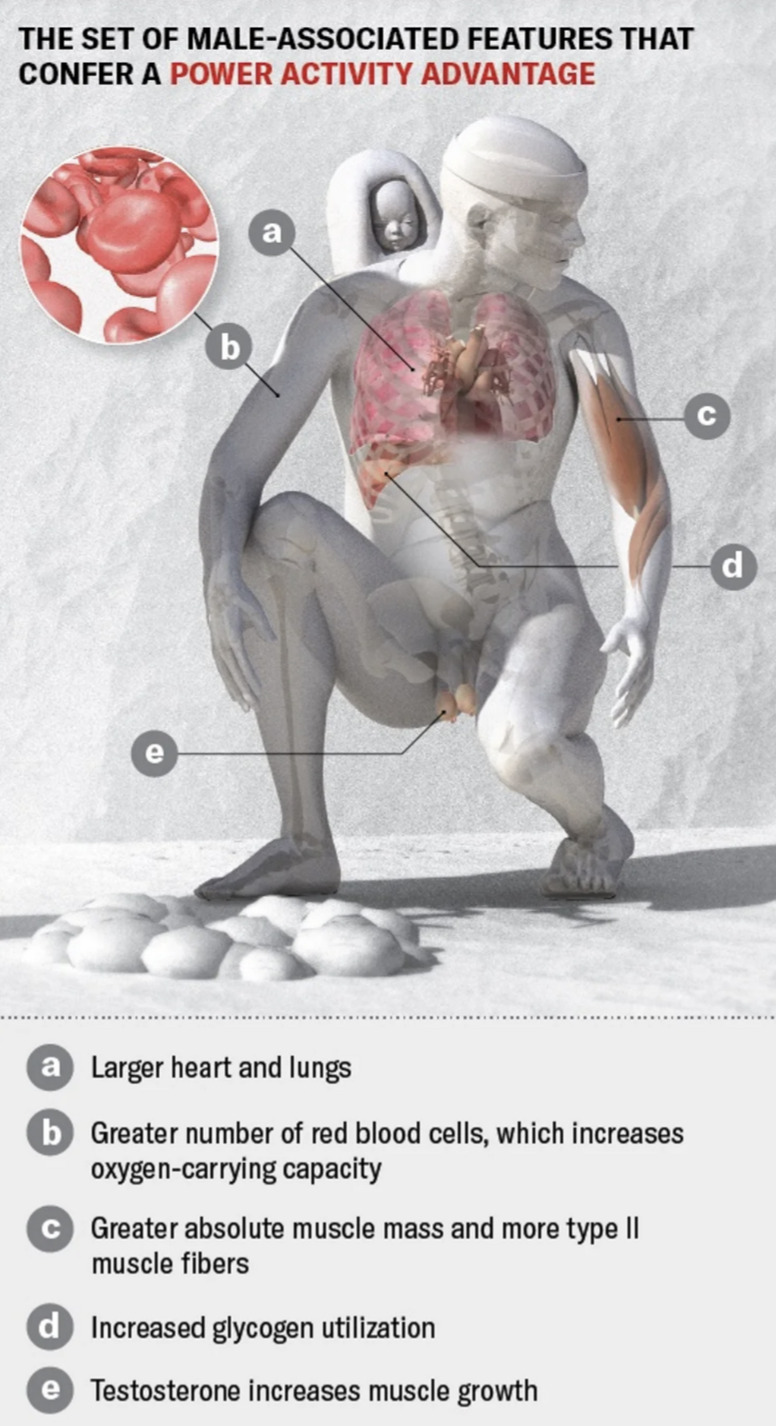
Credit: Violet Isabelle Frances for Bryan Christie Design
Given the fitness world's persistent touting of the hormone testosterone for athletic success, you'd be forgiven for not knowing that estrogen, which females typically produce more of than males, plays an incredibly important role in athletic performance. It makes sense from an evolutionary standpoint, however. The estrogen receptor—the protein that estrogen binds to in order to do its work—is deeply ancient. Joseph Thornton of the University of Chicago and his colleagues have estimated that it is around 1.2 billion to 600 million years old—roughly twice as old as the testosterone receptor. In addition to helping regulate the reproductive system, estrogen influences fine-motor control and memory, enhances the growth and development of neurons, and helps to prevent hardening of the arteries.
Important for the purposes of this discussion, estrogen also improves fat metabolism. During exercise, estrogen seems to encourage the body to use stored fat for energy before stored carbohydrates. Fat contains more calories per gram than carbohydrates do, so it burns more slowly, which can delay fatigue during endurance activity. Not only does estrogen encourage fat burning, but it also promotes greater fat storage within muscles—marbling if you will—which makes that fat's energy more readily available. Adiponectin, another hormone that is typically present in higher amounts in females than in males, further enhances fat metabolism while sparing carbohydrates for future use, and it protects muscle from breakdown. Anne Friedlander of Stanford University and her colleagues found that females use as much as 70 percent more fat for energy during exercise than males.
Correspondingly, the muscle fibers of females differ from those of males. Females have more type I, or "slow-twitch," muscle fibers than males do. These fibers generate energy slowly by using fat. They are not all that powerful, but they take a long time to become fatigued. They are the endurance muscle fibers. Males, in contrast, typically have more type II ("fast-twitch") fibers, which use carbohydrates to provide quick energy and a great deal of power but tire rapidly.
Females also tend to have a greater number of estrogen receptors on their skeletal muscles compared with males. This arrangement makes these muscles more sensitive to estrogen, including to its protective effect after physical activity. Estrogen's ability to increase fat metabolism and regulate the body's response to the hormone insulin can help prevent muscle breakdown during intense exercise. Furthermore, estrogen appears to have a stabilizing effect on cell membranes that might otherwise rupture from acute stress brought on by heat and exercise. Ruptured cells release enzymes called creatine kinases, which can damage tissues.
Studies of females and males during and after exercise bolster these claims. Linda Lamont of the University of Rhode Island and her colleagues, as well as Michael Riddell of York University in Canada and his colleagues, found that females experienced less muscle breakdown than males after the same bouts of exercise. Tellingly, in a separate study, Mazen J. Hamadeh of York University and his colleagues found that males supplemented with estrogen suffered less muscle breakdown during cycling than those who didn't receive estrogen supplements. In a similar vein, research led by Ron Maughan of the University of St. Andrews in Scotland found that females were able to perform significantly more weight-lifting repetitions than males at the same percentages of their maximal strength.
If females are better able to use fat for sustained energy and keep their muscles in better condition during exercise, then they should be able to run greater distances with less fatigue relative to males. In fact, an analysis of marathons carried out by Robert Deaner of Grand Valley State University demonstrated that females tend to slow down less as a race progresses compared with males.
If you follow long-distance races, you might be thinking, wait—males are outperforming females in endurance events! But this is only sometimes the case. Females are more regularly dominating ultraendurance events such as the more than 260-mile Montane Spine foot race through England and Scotland, the 21-mile swim across the English Channel and the 4,300-mile Trans Am cycling race across the U.S. Sometimes female athletes compete in these races while attending to the needs of their children. In 2018 English runner Sophie Power ran the 105-mile Ultra-Trail du Mont-Blanc race in the Alps while still breastfeeding her three-month-old at rest stations.
Inequity between male and female athletes is a result not of inherent biological differences between the sexes but of biases in how they are treated in sports. As an example, some endurance-running events allow the use of professional runners called pacesetters to help competitors perform their best. Men are not permitted to act as pacesetters in many women's events because of the belief that they will make the women "artificially faster," as though women were not actually doing the running themselves.
The modern physiological evidence, along with historical examples, exposes deep flaws in the idea that physical inferiority prevented females from partaking in hunting during our evolutionary past. The evidence from prehistory further undermines this notion.
Consider the skeletal remains of ancient people. Differences in body size between females and males of a species, a phenomenon called sexual size dimorphism, correlate with social structure. In species with pronounced size dimorphism, larger males compete with one another for access to females, and among the great apes larger males socially dominate females. Low sexual size dimorphism is characteristic of egalitarian and monogamous species. Modern humans have low sexual size dimorphism compared with the other great apes. The same goes for human ancestors spanning the past two million years, suggesting that the social structure of humans changed from that of our chimpanzeelike ancestors.
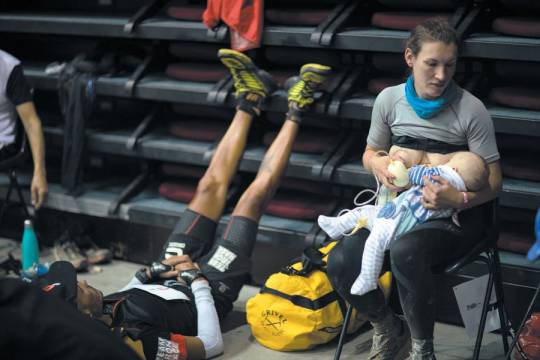
Sophie Power ran the 105-mile Ultra-Trail du Mont-Blanc race in the Alps while breastfeeding her child at rest stations. Credit: Alexis Berg
Anthropologists also look at damage on our ancestors' skeletons for clues to their behavior. Neandertals are the best-studied extinct members of the human family because we have a rich fossil record of their remains. Neandertal females and males do not differ in their trauma patterns, nor do they exhibit sex differences in pathology from repetitive actions. Their skeletons show the same patterns of wear and tear. This finding suggests that they were doing the same things, from ambush-hunting large game animals to processing hides for leather. Yes, Neandertal women were spearing woolly rhinoceroses, and Neandertal men were making clothing.
Males living in the Upper Paleolithic—the cultural period between roughly 45,000 and 10,000 years ago, when early modern humans entered Europe—do show higher rates of a set of injuries to the right elbow region known as thrower's elbow, which could mean they were more likely than females to throw spears. But it does not mean women were not hunting, because this period is also when people invented the bow and arrow, hunting nets and fishing hooks. These more sophisticated tools enabled humans to catch a wider variety of animals; they were also easier on hunters' bodies. Women may have favored hunting tactics that took advantage of these new technologies.
What is more, females and males were buried in the same way in the Upper Paleolithic. Their bodies were interred with the same kinds of artifacts, or grave goods, suggesting that the groups they lived in did not have social hierarchies based on sex.
Ancient DNA provides additional clues about social structure and potential gender roles in ancestral human communities. Patterns of variation in the Y chromosome, which is paternally inherited, and in mitochondrial DNA, which is maternally inherited, can reveal differences in how males and females dispersed after reaching maturity. Thanks to analyses of DNA extracted from fossils, we now know of three Neandertal groups that engaged in patrilocality—wherein males were more likely to stay in the group they were born into and females moved to other groups—although we do not know how widespread this practice was.
Patrilocality is believed to have been an attempt to avoid incest by trading potential mates with other groups. Nevertheless, many Neandertals show both genetic and anatomical evidence of repeated inbreeding in their ancestry. They lived in small, nomadic groups with low population densities and endured frequent local extinctions, which produced much lower levels of genetic diversity than we see in living humans. This is probably why we don't see any evidence in their skeletons of sex-based differences in behavior.
For those practicing a foraging subsistence strategy in small family groups, flexibility and adaptability are much more important than rigid roles, gendered or otherwise. Individuals get injured or die, and the availability of animal and plant foods changes with the seasons. All group members need to be able to step into any role depending on the situation, whether that role is hunter or breeding partner.
Observations of recent and contemporary foraging societies provide direct evidence of women participating in hunting. The most cited examples come from the Agta people of the Philippines. Agta women hunt while menstruating, pregnant and breastfeeding, and they have the same hunting success as Agta men.
They are hardly alone. A recent study of ethnographic data spanning the past 100 years—much of which was ignored by Man the Hunter contributors—found that women from a wide range of cultures hunt animals for food. Abigail Anderson and Cara Wall-Scheffler, both then at Seattle Pacific University, and their colleagues reported that 79 percent of the 63 foraging societies with clear descriptions of their hunting strategies feature women hunters. The women participate in hunting regardless of their childbearing status. These findings directly challenge the Man the Hunter assumption that women's bodies and childcare responsibilities limit their efforts to gathering foods that cannot run away.
So much about female exercise physiology and the lives of prehistoric women remains to be discovered. But the idea that in the past men were hunters and women were not is absolutely unsupported by the limited evidence we have. Female physiology is optimized for exactly the kinds of endurance activities involved in procuring game animals for food. And ancient women and men appear to have engaged in the same foraging activities rather than upholding a sex-based division of labor. It was the arrival some 10,000 years ago of agriculture, with its intensive investment in land, population growth and resultant clumped resources, that led to rigid gendered roles and economic inequality.
Now when you think of "cave people," we hope, you will imagine a mixed-sex group of hunters encircling an errant reindeer or knapping stone tools together rather than a heavy-browed man with a club over one shoulder and a trailing bride. Hunting may have been remade as a masculine activity in recent times, but for most of human history, it belonged to everyone.
27 notes
·
View notes
Text
the Xa
I wasn't planning on revealing another sophont, but it's a creature I have a decent amount of information and sketches on, so I decided to post it while I work on some complex 3D art for this world.
The Xa are tall black birds you may have seen in the Intro to Total Convergence..?.

These two meter tall avians use their wings for walking. Their thumb has increased in size and the claw has re-appeared and modified into a hoof. They primarily use their beaks for manipulating with objects, but their feet, which the Xa leave off the ground when walking, greatly assist with this. Another ancient feature that has re-appeared in this bird are the teeth, but they aren't used for eating. The teeth of the Xa have bright golden and dark red stripes and are flattened, resembling our incisors, and are used as a dispaly structures during communication.
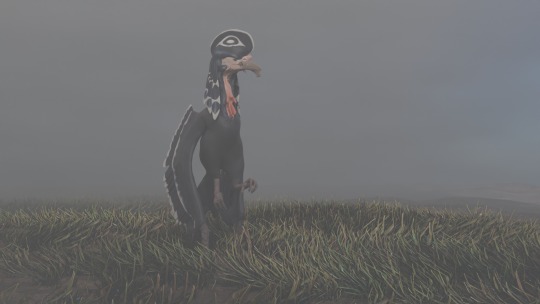
Normally, a Xa would walk around with their head resting on the neck, their beak covered up by their thick plumage. This one got startled by a distant noise and is looking around.
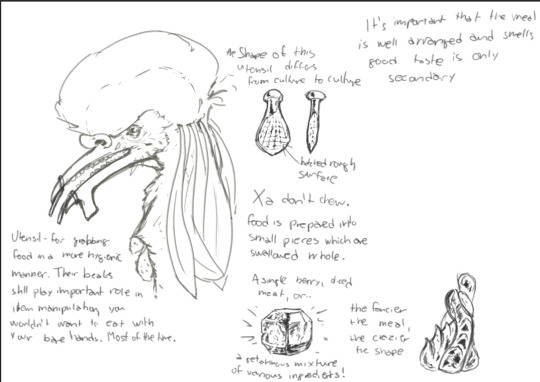

I'm still deciding whether to keep the "lip pads" or not.
A Xa's perception of reality and the rate at which they take in information is also remarkably fast. An average Xa, for example, is able to read one A4 page full of text in circa five seconds. This means that a Xa can graduate way faster than a human, making up for their short lifespan. This is one of the reasons why it can be hard for them to enjoy movies, the ones that were made by non Xa are unwatchable because of the "low frame rate".
There is almost no sexual dimorphism in these birds. On normal occasions the gender nor sex of a Xa is not distinguished at all, and probably no Xaian cultures have different social roles for men and women. The only way to tell the sexes apart is through pheromones, which are only released on special occasions. Only Xa are sensitive to these pheromones, and non avians wouldn't be able to tell the difference at all.
The Xa are relatively short lived, maturing at the age of seven. In the prehistory, they could live up to be twenty years old, but thanks to modern medicine, their lifespan has increased to be up to thirty years. When hatched, a baby Xa is born featherless, growing a coat of ash-brown downy feathers after ten months. A "pre-teen" coat - black contour feathers - begins to appear at the age of four, and at the age of seven, the "adult" plumage with its characteristic white eye pattern and contrasting, irridescent black feathers on the Xa's crest appears. These white patterns typically fade to gray with old age. The irridescence is also a lot less striking in older Xa.
Due to their plumage, they don't really need soft fabric to make their clothes comfortable, they mostly focus on making waterproof and elegant garments. But soft fabric can sometimes be a sign of the wearer's status. Because of their reliability on their beak as our equivalent of hands, the great majority of utensils and tools are made to be carried in and controlled by the beak. Tools and guns specificaly are mostly attachment based - there are several types of universal helmets that are used to attach a variety of tools to them. A lot of guns can be operated with both beak and hands. Shooting a gun is a lot easier when a Xa uses their beak, but hands are more practical when they need to quickly draw the weapon.
More on their evolution later!
#artists on tumblr#creature design#speculative evolution#worldbuilding#digital art#spec bio#spec evo#speculative fiction#3d#3d art#3d render#3d model#blender#art#bird art#creature#artwork#speculative biology
104 notes
·
View notes
Note
@ your tags PLEASE talk abt your parker designs!!!
this is for you and @dreaming-of-stories-and-stars THANK YOU for enabling me :3 sorry this took a little bit
if you don't know what this is about i drew my takes on the parkers here !
rambles under the cut:
SO what i sorta wanted to do was make. each parker flow into the next while subtly changing in between ,,, something something losing yourself to the game, becoming unrecognizable. so let's cover it parker by parker:
prime: i personally Love the hc that the coin is parker's mom. so prime is a lil ancient roman coded guy. he's SOOOO eldest sibling coded help. like he and his mom have a very strained relationship but also he thinks that if he just does whatever she wants she'll finally be proud of him :P whoops! and yeah v explosive anger (firewalker reference!), leading to ego, leading to. You Know. anyway. oh ALSO the parkers get younger as we progress so :))) they all STARTED at 19 but have varying degrees of age. so prime is in his mid-thirties.
parker ii: AH the most elusive of the parkers. SO: in my personal lore interp, parker ii was created when prime starting to push back against the coin more and more to the point where it was becoming a problem. and prime of course is very destructive and makes a mess when he's angry. so ii came about from me going "...what if parker just. said fuck it and left. didn't give a shit about ego just didn't wanna play the game anymore and found a way out." and that's exactly what my ii did. absolutely fucking vanished and quit the game for good. somehow. which uhhh MIGHT have been what caused prime to go apeshit ("why does ii get to leave and i'm stuck here?") and end prehistory. whoops. so i wanted to make them look very vagabond-y. somehow got even edgier than prime (impressive). also they're abt 30-ish. and have crazy gender stuff going on. possibly transfem. "but how is that possible if you hc the parkers as transmasc-" shhh. i don't know <3
park3r: GOD i loved doing this one. this parker is such a bitch and i love him. the first commissioner parker, created bc "OKAY so we gotta make him more young and impressionable and less unstable AND take him out of this game bc very clearly Bad Things will happen if he stays" so they made. a chronically online teenager and made them commissioner AMDNFM. god yeah i love this design he's sooo. just a 19-year-old trying to fill an impossible role and putting on a cool face about it. tragic, yes. but they're gonna complain the whole time and make everyone else miserable too. fully believe he was just scared and out of his depth the whole trial :( oops why are parkers iii and iiii so sad. i drew him closer to mid-20s here but honestly he could easily be younger
p4rker: LOVE this guy's lore so my hc is that after the trial that killed park3r it was like "uhhhh FUCK we need a new one of those. stat." so. they just. took park3r's incin'd body (ik it's not really Canon that park3r was incin'd he just Died but. let me have this) and like. stitched it back together. so p4rker is covered in burns and stitched together like frankenstein all over, and they just threw a mask on them like "see!!! new guy!!" the result of this being they didn't have. a whole ton of time to add shit like Personality, so p4rker is the outlier in that they're very naive and even polite? they don't understand what all the fuss is about them and just wants to be. nice? shame he didn't stick around long :/ the drippy bits are a little percolation nod! in this particular drawing he's like 20 :(
pvrker is. obviously the least human. park3r was more of a prototype of a commissioner, p4rker was a temporary placeholder at best, pvrker... was well and truly made For The Game. and his appearance reflects that. kinda a combination of iii's bluntness and 4's naivety. in-universe some people think he's the most sinister or whatever bc he's so directly Controlled By ILB Shit and that's not NOT true but like. give him a break guys he's like 6 days old he's new at this :(
ANYWAY that's so long holy shit. here are my rambles i hope u like them. im So Bad at blaseball lore so someone yell at me if something i put in there isn't accurate but. yeag :)
#parker macmillan#blaseball#WOO god this took so long to write and so much of it is just vibes but. I Like Them :)#they're so fun to draw!! so similar but different!!! h!!!!!#sol speaks
18 notes
·
View notes
Text
Analysis of data from dozens of foraging societies around the world shows that women hunt in at least 79% of these societies, opposing the widespread belief that men exclusively hunt and women exclusively gather. Abigail Anderson of Seattle Pacific University, US, and colleagues presented these findings in the open-access journal PLOS ONE on June 28, 2023.
A common belief holds that, among foraging populations, men have typically hunted animals while women gathered plant products for food. However, mounting archaeological evidence from across human history and prehistory is challenging this paradigm; for instance, women in many societies have been found buried alongside big-game hunting tools.
Some researchers have suggested that women's role as hunters was confined to the past, with more recent foraging societies following the paradigm of men as hunters and women as gatherers. To investigate that possibility, Anderson and colleagues analyzed data from the past 100 years on 63 foraging societies around the world, including societies in North and South America, Africa, Australia, Asia, and the Oceanic region.
They found that women hunt in 79% of the analyzed societies, regardless of their status as mothers. More than 70% of female hunting appears to be intentional—as opposed to opportunistic killing of animals encountered while performing other activities, and intentional hunting by women appears to target game of all sizes, most often large game.
The analysis also revealed that women are actively involved in teaching hunting practices and that they often employ a greater variety of weapon choice and hunting strategies than men.
These findings suggest that, in many foraging societies, women are skilled hunters and play an instrumental role in the practice, adding to the evidence opposing long-held perceptions about gender roles in foraging societies. The authors note that these stereotypes have influenced previous archaeological studies, with, for instance, some researchers reluctant to interpret objects buried with women as hunting tools. They call for reevaluation of such evidence and caution against misapplying the idea of men as hunters and women as gatherers in future research.
The authors add, "Evidence from around the world shows that women participate in subsistence hunting in the majority of cultures."
#the myth of men as hunters and women as gatherers#hunter gathers#human history#article#anthropology#history#science news#science history#bias
26 notes
·
View notes
Note
Hey there, been slowly crawling through your blog after reading a couple of your things (surprisingly came from your elden ring work but happy to discover you write for dragon age and star wars too). Do you work in heritage? I have really enjoyed how in depth a lot of your worldbuilding is regardless of what world you write for and wondered how that may have influenced your work.
I primarily work in archaeological fields! I’ve done jobs as assistant collection managers + european prehistory research roles too. I studied both archaeology and anthropology as an undergrad though so my thought process is very anthropological (though specifically UK trained, US anthro and arch is very different).
It’s definitely shaped my writing - not just in the sense of my understanding of culture and worldbuilding, but I would say it has changed the questions I ask myself as a writer. It comes out more in my original writing than my fanfics though I would say, since in that I am wholly focused on speculating about all the different ways we as humans could exist, such as political and familial structures, gender constructions or lack of, dissolution of nature/civilisation or biology/culture divides etc. Both disciplines help me really get into the cultural eye of a character as it were though.
#it is interesting seeing the number of fantasy/sci fi writers that come from these two disciplines or have links to them#in many ways i think the reports i write for my day jobs often are just another form of speculative fiction#i am trying to imagine and interpret best another way of seeing and moving through the world#based on a lot of hard sought and heavily scrutinised evidence i should emphasise#but i am still trying to understand another person's whole world and that takes imagination and willingness to let yours crumble briefly
3 notes
·
View notes
Text
The newly emerging registers of sex/gender and sexuality were inextricably entwined through the hegemonic discourse of evolutionary theory. Determined to reorder dominant social hierarchies, scientists explained deviations of normative being and behavior in terms of a hetero-teleological scale of evolutionary development. Blacks, homosexuals, children, and women were situated at lower points on this scale than white heterosexual men, not able (or not yet able) to reach the highest stage of (hu)man evolution. The category of bisexuality played a central role in this linear model, and thus in the epistemological configuration of the category of sexuality (Angelides, 2001). The human differences of race, age, gender and sexuality were thought to be the effect of a specific temporal and spatial relation to what evolutionists and sexologists referred to as primordial hermaphroditism or embryological bisexuality. Believed to be the earliest form of human ancestry, primordial hermaphroditism, or bisexuality, as Frank Sulloway (1979, p. 179) points out, became the evolutionists “missing bisexual link.” This was confirmed by recapitulation theory, which posited that the human embryo repeated “in its own life history the life history of the race, passing through the lower forms of its ancestors on its way to maturity” (Russett, 1989, p. 50). In other words, as Charles Darwin (1927 [1871], p. 525) posited, every individual “bears rudiments of various accessory parts, appertaining to the reproductive system, which properly belong[s] to the opposite sex.” This meant that blacks, women, children and homosexuals were thought to be the effect of an unsuccessful evolution, closer to, or retaining many more elements of, the originary (pre-historic) bisexuality of the human race and individual embryo. Put differently, an individual’s distance from this state of primordial bisexuality dictated the degree of one’s evolutionary advancement. Within this framework, therefore, the axes of race, age, gender and sexuality were defined and aligned by their very relation to bisexuality.
However, bisexuality posed a problem for sexological discourse. In the attempt to catalogue human sexual behavior, sexologists were [confronted] with the dilemma of containing its variant forms within the nascent and rigid oppositional categories of hetero- and homosexuality. After all, even in his 1897 publication, Sexual Inversion, Havelock Ellis (1897, p. 133) acknowledged the “person who is organically twisted into a shape that is more fitted for the exercise of the inverted than of the normal sexual impulse, or else equally fitted for both” (emphasis added). Similarly, Krafft-Ebing (1965, pp. 373-385) had identified what he called “psychical hermaphroditism.” Yet, sexology was unable to account for bisexuality as a form of sexuality. For instance, on the one hand, Ellis (1928 [1901], p. 88) claimed that “[t]here would seem to be a broad and simple grouping of all sexually functioning persons into three comprehensive divisions: the heterosexual, the bisexual, and the homosexual.” Yet, on the other hand, he affirmed like Krafft-Ebing, that “[m]ost of the bisexual prefer their own sex . . . [and that this] would seem to indicate that the bisexuals may really be inverts.” “In any case,” stated Ellis (1928 [1901], p. 278), “bisexuality merges imperceptibly into simple inversion.”
The difficulty for sexologists constrained by a linear logic of temporal succession was how to reconcile bisexuality as at one and the same time a biological cause (embryological bisexuality) and a psychological effect (bisexual identity). Ultimately, bisexuality as a form of sexuality or identity had to be refused in the present tense.5 That is to say that bisexuality always had to be somewhere else–in the embryo, the sphere of human prehistory–or something else–either really heterosexual or homosexual. It could never be a stable sexual identity in the here and now otherwise the epistemological integrity of the very categories of man, woman, heterosexual and homosexual would be thrown into doubt (Angelides, 2001).
steve angelides, historicizing bisexuality p. 130-132
3 notes
·
View notes
Note
Hello! I was listening to one of the Below Decks episodes a while ago, and in one, you mentioned how historically, Western gender roles were created/have been used to make colonialism easier. I'm working on an academic thing where I'm considering bringing this up, and I was wondering if you remembered any of the places you read this? Discussion/essay type sources are preferred (for my own readability lmao) but contemporary pieces would also be really helpful! Thank you, and I'm really enjoying the show!!
Hello friend - here are some good places to start, though as ever you'll find some bangers in their bibliographies :D
Reading:
McClintock, Anne. Imperial Leather: Race, Gender, and Sexuality in Colonial Contest. Routledge. 1995.
Redman, Samuel J., Bone Rooms: from scientific racism to human prehistory in museums. Harvard University Press. 2016.
Saini, Angela. Superior: The Return of Race Science. Beacon Press. 2019.
Schuller, Kyla. The Biopolitics of Feeling: Race, Sex, and Science in the Nineteenth Century. Duke University Press, 2018.
Wickramasinghe, Nira. Colonial Servitude And Resistance In Sri Lanka. Colombia University Press, 2020.
Watching:
Little Bear, Leroy. “Big Thinking and Rethinking: Blackfoot metaphysics 'waiting in the wings'. Reflections by a Blackfoot.” University of Calgary - Humanities and Social Sciences Congress 2016. https://www.youtube.com/watch?v=o_txPA8CiA4
Linnaeus Society. "Linnaeus, Race and Sex" https://youtu.be/BliDKUS_XKg (Notes can be found here: https://www.linnean.org/learning/who-was-linnaeus/linnaeus-and-race)
Hope that helps, and good luck with your research :)
28 notes
·
View notes
Text
about me:
u can call me dippy or dip
i am currently 18
male, he/him
not human
i am gay, aroace, and greyaplatonic
i am autistic, with adhd and mental illnesses
disabled
digital artist
furry
punk, metalhead, alternative
embodiment of "erm actually" and i have a chronic stick up my ass
i have the rude flavor of autism, i come off as passive aggressive but i am just blunt and genuine. i also have issues with empathy and tone, i take everything seriously and at face value
interests:
cartoons:
ed edd n eddy
TMNT (rise, 2012, and mutant mayhem)
pinky and the brain
metalocalypse
regular show
invader zim
futurama
craig of the creek
kick buttowski
out there 2013
catscratch
rick and morty
solar opposites
whatever happened to robot jones
smiling friends
gravity falls
other media:
criminal minds
undertale and deltarune
freaks and geeks
DHMIS
the nightmare before christmas
beastars
mr. robot
blorbos:
topher bus - clone high - kin
toki wartooth - metalocalypse - kin
duck - DHMIS - kin
allan - smiling friends - kin
donnie - ROTTMNT - kin
raph - 2012 TMNT - kin
ed - ed edd n eddy
papyrus - undertale
rigby - regular show
bender - futurama
waffle - catscratch
giovanni potage - epithet erased
music:
favorite genres: rock, metal, folk punk, midwest emo, alternative/indie, losercore
favorite artists: ICP, harley poe, AJJ, jack stauber, three days grace, korn, MSI, slipknot, avenged sevenfold, thousand foot krutch, rob zombie, lil darkie, linkin park, system of a down, the front bottoms, mccafferty, set it off, weezer, radiohead, pierce the veil, seether, black veil brides, escape the fate, crywank, deftones, modern baseball, will wood, glass animals, dethklok
other interests/likes:
science: sociology, psychology, psychopathology, biology (human and animal), astronomy, ecology, pathology, anthropology, paleobiology, archeology, taxonomy
linguistics, semantics, dialect, grammar, etymology, obsolete words, currently learning spanish, german, and hebrew
philosophy and politics
learning, researching, reading, making lists
sci-fi, fantasy, cryptids, scp, mythology
prehistory: i love the early paleozoic era the most (cambrian), but i also like dinosaurs and other extinct things
animals: i like animal biology, relationships, etc. marine animals are my favorites
clowns/clowncore: i like classic circus clowns, jesters, mimes, scary clowns, i like ICP, the joker, pennywise, i like circuses and carnivals in general as well. i also enjoy magic tricks and performance art
coffee
puns and shitty word play
eyesore art, psychedelics, things that glow in the dark, colored lights, trippy shit
collecting: rocks, bones, animal things (teeth, feathers, etc), shells, cool shaped glass and bottles, random blue things
taxidermy, graffiti, stop motion animation, and puppetry are art forms i enjoy but do not make
art/animated gore, violence, cannibalism, upsetting themes i guess?
dislikes:
astrology, fate, etc
guessing or gambling
all asmr, whitenoise
role playing (participating)
most sitcoms
reality tv, talk shows, game shows
most anime
most sex jokes/toilet humor
social rules/norms
sleeping
3 notes
·
View notes
Text
A bit of a long and soppy post but I’d like to take it out of my system in what is for me a very safe space since very few people I know also know me here (and I’d have no issues discussing the following with them!)
As much as social media can be an absolute hellscape, I have to absolutely admit that at least for me they have been an incredible lifeline. I grew up in rural Italy in the 90s: no internet, extremely limited access to entertainment, you’d have to go to the “town” to get any magazine or book you might be interested in, and that if you were lucky enough for it to have been delivered. I know that lately rural Italy has been heavily romanticised but trust me, it can be hell.
I was of course a very shy, traumatised, and awkward only child already immersed in my own fantasy world, and not having a single person I could share my interests with only made me even weirder and retreated. Finally gaming consoles arrived and became a bit popular towards mid-end of the 90s, so at least I had a couple of classmates I could talk to. However, a whole separate post would be needed to discuss about gender roles and how sectarian the access to more typically “male” entertainment is still proudly gatekept by some groups (I am a cis female). Videogames were “boys” things, and lots of parents would keep their daughters away from them. I felt out of place, constantly. But I digress.
In the 2000s I started hanging around on MySpace, forums and the early form of Facebook (which too many people on this website definitely sounds like pure prehistory), moving then to online gaming with World of Warcraft. It was like opening a Pandora’s box, but in the best possible way: there were hundreds of people you could discuss with, all hidden behind avatars, and couldn’t care what you looked like. It was enough of a connection to make me feel seen and understood, there was someone else out there thinking the same things and wanting to share the same passions. Anything you like (hopefully still in the realm of healthy interests) rest assured you will find a somewhat active community. For example, when I randomly picked up Mass Effect to play on the PS4 because it had been sitting on my "to play" list, I absolutely wasn’t expecting to find such an active community for a game that is 16 years old. It’s basically an aeon in today’s society. It pains whenever I see drama or pure toxicity against people’s simple preferences, especially when it comes from people in my demographic that should absolutely know better on how to preserve these virtual spaces (and unfortunately most of the time are the ones that turn into revenge bullies)
Please keep sharing all your art, writing, memes, comments, anything that enriches the space, because somewhere out there someone is truly looking forward to it.
3 notes
·
View notes
Text
New Doctor Who book review on Blogger & Goodreads✨: Only Human, DW New Series Adventures #4 with the Ninth Doctor and Rose Tyler. A feminist review of a problematic author (ie, Gareth Roberts :S), also featuring a discussion on Prehistory, Neanderthals vs Homo sapiens, huntresses, and gender roles in Prehistory ♀️🏹
#doctor who#rose tyler#9th doctor#ninth doctor#prehistory#herstory#neanderthals#homo sapiens#history#doctor who reviews#feminism#my works#only human
1 note
·
View note
Text

ACTIVE SETTLER-COLONIALISM ARTWORK 1
This Cherokee Booger Mask was made in the early 19th century by an artist once known. The materials are all naturally sourced and are repurposed directly from the environment. The mask is made primarily from a mixture of carved gourd, feather, and string. The Booger mask would be seen used in ceremonial and social dances, and a man would dress himself up in ragged clothing, putting on the Booger mask he would then approach the dancers, and in costume would proceed to instigate and frighten the crowd (Infinity of Nations: Art and History in the Collections of the National Museum of the American Indian). The individual who wore the Booger mask would also afterwords perform his own solo dance as a part of the tumultuous performance (Infinity of Nations: Art and History in the Collections of the National Museum of the American Indian). Additionally, there was also a Bugah or Booger dance, which was a winter event where masked dancers would celebrate gender and role reversals, in attempts to “weaken the harmful power of alien tribes and races, either living or dead, who may cause sickness or misfortune (Power 2007, 150-152).
The traits in this artwork are comical and crass, bordering on the margins between humor and terror. The mask has a long, elongated nose perhaps meant to exhibit attributes that more commonly appeared in European settlers (Infinity of Nations: Art and History in the Collections of the National Museum of the American Indian). The exaggerated facial features are made to appear more or less human, but the application of over emphasis is utilized also to instill a sense of fear and unease in the viewer (Infinity of Nations: Art and History in the Collections of the National Museum of the American Indian). The Booger mask served a performative purpose to the Cherokee, but also as a stern reminder of the dangers of outside forces that threatened the community (Infinity of Nations: Art and History in the Collections of the National Museum of the American Indian). The National Museum of the American Indian states that Cherokee beliefs revolved around the notion that illness originated from the outside of their settlements, and the Booger mask and the character it portrayed in performance enacted the threat of external forces (national museum of the American Indian). Booger masks would also vary in that they could portray a variety of expressive features (Power 2007, 150).
This artwork was created during active settler colonialism, as one of the primary purposes of this Booger mask and its overall character and demeanor was to represent a warning of the outside forces (Infinity of Nations: Art and History in the Collections of the National Museum of the American Indian). In this case, one of the primary outside forces that this intruder depicted was the Europeans settlers. The Booger Mask is a direct recognition in which the Cherokee had embodied and presented the fear and distress that they felt for their people during active colonialism. Its purpose and function posed as a dialogical deterrent, the performance of the ceremony with the Booger mask was a mode in which they communicated the past and present consequences that the European settlers were actively creating against indigenous people.
Sources:
“Cherokee Booger Dance Mask.” Infinity of Nations: Art and History in the Collections of the National Museum of the American Indian. Accessed April 18, 2024. https://americanindian.si.edu/exhibitions/infinityofnations/woodlands/237839.html.
Power, Susan C. Art of the Cherokee : Prehistory to the Present. Athens, GA ; University of Georgia Press, 2007.
Unknown. Booger Mask with Long Nose. Early 19th Century CE. Mask: carved gourd with feather and string, Height: 9 in. (3.5 cm). National Museum of the American Indian, Smithsonian Institution, New York, USA; North Carolina, USA. https://jstor.org/stable/community.11677591.
0 notes
Text
So, based on the (reasonable, evidence supported) assumption that the phenemonon we label as "transgender" is a universal one (that is, not bound by time, culture or genetics), it follows that there would have also been trans people in prehistory.
However, given a large part of how we express this phenomenon is through societal lenses of gender roles, I also have to wonder if the Hypothetical Paleolithic Trans Woman would have ever taken steps to socially transition, or if this was even something their society allowed for.
That said, I am highly tickled by the idea of the Trans Smilodon-girl making rock art in their spinny skirt.
0 notes
Text
CIS Infertility Dysphoria?
Internalized anger, disgust, and guilt
There are many personal elements specific to myself which amplify my particular reaction to infertility. I won’t go into specific detail on every aspect because I don’t want to throw people “under the bus” and I don’t want to dox myself. At the time I first began treatment I was already feeling highly resentful about non-medical reasons why I hadn’t had a child yet. Although my feelings were valid, when I learned how incompatible with pregnancy I was, I felt like the denial of my desires had been justified. One of many instances where someone else’s judgment turned out to be better than my own.
So, it is fair to say that I was already unhappily resigned to possibly being childless not by choice when I first sought treatment for my fibroid. And, because of this, I thought that I had already made peace with not having children (untrue), so I waved off any offers of mental support when that coffin was nailed shut for good.
At any rate, the anger and frustration I had been suppressing right before my physical infertility journey was redirected to a creative outlet. I was involved in a couple of different fanfiction groups online. In one I began cowriting a story that centered on an institutionalized forced reproduction system (think kind of like Handmaid’s Tale but with non-humans). It was a terrific outlet and our story eventually got published which went a huge way towards taking the sting out of my denied procreation. Furthermore, the species in this fandom were hermaphrodites so I was well versed in complexity and malleability of gender roles, which has served me well.
It also goes without saying that I was in a bit of a goth phase at the time. I was also casually involved in Wiccanism, but that only twisted the knife because of the heavy celebration of fertility as synonymous with the divine feminine.
Both of these pursuits fell away after my hysterectomy. As I mentioned before, the sacral chakra is a center of creativity as well as reproduction creation. I was supposed to be writing the sequel to our book which I’d already started (but lost in a computer transfer). It was a very dark story and I was so wounded already that I just couldn’t bring myself to “go there.” I ended up ghosting my publisher (I didn’t have an advance or anything) and never wrote it. One of my many regrets in life. I should have reached out for help. I was a beta reader and editor for a while. But my passion for that eventually waned as well.
I could no longer hold down a job. My heart wasn’t in anything – everything seemed pointless. I eventually ended up mixed paint at a Home Depot. I’m glad for that experience overall, but I was crushed every time a happy expectant couple came in lovingly and excitedly picking out nursery colors. I learned to take off the day for Mother’s Day each year.
I had also started self-harming. Not frequently or severely. I was also self-harming subconsciously. I began putting on weight rapidly following my hysterectomy. I’d always been very thin as a child, teen, and youth. There were times when I was softer and I foolishly fret over five or ten pounds.
Circumstances all combined to have me rapidly packing on pounds steadily after the hysterectomy. Ultimately, I blame myself. I feel very strongly that the self-hatred and depression contributed to my not giving a fuck about my health so long as I passed the physical examination, I needed to update every so often for the adoption paperwork.
The irony is that I would have gloried in the weight gain had it been part of pregnancy. I could have basked in the sensualness of my abundant curves as an homage to the voluptuous fertility goddesses of prehistory. But for a poisonous, barren thing such as myself to look so bountiful has always been such a blasphemy in my mind. I felt like I should be skeletal and bent with blackened claws and grey hair. Maybe my subconscious was trying to emulate the pregnancy weight, but more likely I was just comfort eating, while working odd hours and relying on fast or processed foods while my metabolism tanked due to free-falling hormones and stress.
Remember this controversial scene https://youtu.be/OJGGWhQBpOg? Unlike most people I actually related to Natasha and defended the scene in conversations online. While I felt like a monster because my body was poisonous, I argued that Natasha felt like a monster not because she couldn’t have children but because she’d been so ambitious in wanting to be a great Black Widow she’d chosen that monstrous path which included sterilizing herself. It’s only in reflection that I realize I was projecting. Natasha in the movie tried to fail her final test to avoid the sterilization. I was the one who chose mine.
0 notes